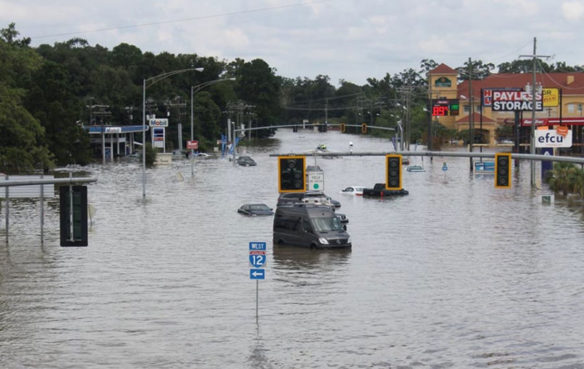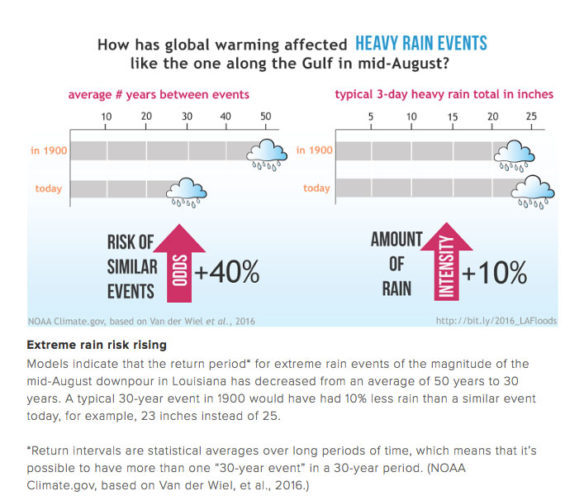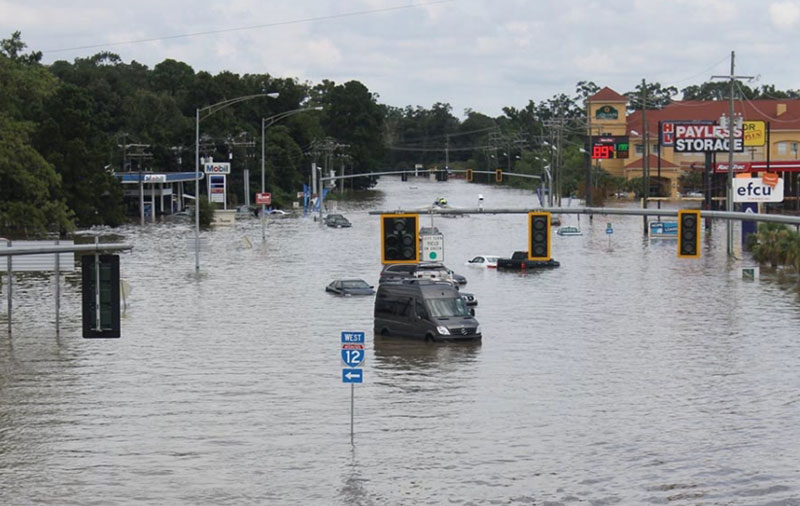
By NOAA;
Human-caused climate warming increased the chances of the torrential rains that unleashed devastating floods in south Louisiana in mid August by at least 40 percent, according to a team of NOAA and partner scientists with World Weather Attribution (WWA) who conducted a rapid assessment of the role of climate on the historic heavy rain event.
“We found human-caused, heat-trapping greenhouse gases can play a measurable role in events such as the August rains that resulted in such devastating floods, affecting so many people,” said Karin van der Wiel, a research associate at NOAA’s Geophysical Fluid Dynamics Laboratory and the lead author. “While we concluded that 40 percent is the minimum increase in the chances of such rains, we found that the mostly likely impact of climate change is a near doubling of the odds of such a storm.”

For the assessment, scientists conducted a statistical analysis of rainfall observations and used two of NOAA’s high-resolution climate models to understand how the odds have changed for such three-day events between the early 20th century and the early 21st century. The results were consistent using observational data and climate models.
“This was by far the hardest fast attribution study we have done, given all the different small-scale weather types that cause precipitation in the region,” said Geert Jan van Oldenborgh of the Royal Netherlands Meteorological Institute, part of the international research network known as WWA that was formed to provide near real-time analysis of extreme weather events. “It was encouraging to find that our multi-model methods worked even for such a complicated case.”

Aerial view of flooding in Denham Springs, Louisiana.
Aerial photo on the left of Denham Springs, Louisiana at the height of the flooding on August 15, 2016, collected by NOAA’s National Geodetic Survey at sites identified by NOAA’s National Weather Service and the Federal Emergency Management Agency. The photo on the right was taken three days later when flood waters had receded. (NOAA)
The research focused on the central U.S. Gulf Coast, and investigated events as strong as that observed at the height of the storm (August 12-14) to provide a regional context and a broader assessment of risk. The climate model experiments involved altering the climate based on levels of greenhouse gases in the atmosphere, aerosols such as soot and dust, ozone and natural changes in the sun’s radiation and from volcanic eruptions for various periods of time to assess how extreme rainfall events respond to climate changes.
“Extreme event attribution analyses are meant to characterize the changing nature of weather risk,” said Heidi Cullen, chief scientist at Climate Central, an independent climate science and news organization that leads WWA. “The information is critical to insurers, policy makers, engineers and emergency managers as they work to make communities more resilient.”
The storm began when a low-pressure system carried massive levels of moisture from an unusually warm Gulf of Mexico over south Louisiana where the system stalled, leading to record breaking precipitation in the region around Baton Rouge. The rains were followed by inland flash flooding and river flooding that was slow to recede due to flooding downstream. As of Aug. 17, Louisiana officials reported that the flood had claimed 13 lives, more than 30,000 people had been rescued, more than 8,100 slept in shelters, and more than 60,000 homes had been damaged.
The rapid assessment was submitted to the open access journal Hydrology and Earth System Sciences Discussionsoffsite link, which has an open online peer review process. The rapid response research is two fold, providing useful information about a severe event nearly immediately to help scientists analyzing the event. However, the research also goes through a more lengthy open comment period and peer review. The robust findings from that process will advance our knowledge on the topic.
A science summary of the paper can be found at World Weather Attribution Climate Central
A feature on this climate attribution research can be found at NOAA Climate.gov
Original Article And Learn More, NOAA (09-07-2016)
Climate change will redraw Louisiana’s flood risk maps; Newsweek (08-18-2016)
There is a lot of water in southern Louisiana right now. But the climate science prognosis doesn’t look good. This is the eighth time in about a year that 500-year rainfall has hammered the U.S., and climate change will make extreme weather events like this more common…









